Size table of water pipes: selection of products for solving
Anyone who plans to install the water supply system on their own should study the standard dimensions of the water pipes on the market. This information will be very useful, because only knowing the sections and diameters of the parts that are used in the work, we will be able to select the appropriate fittings and adapters, as well as equip the connection to household appliances.
Below we provide general information about pipe sizes, as well as provide reference data that will facilitate your selection of equipment at the design stage.
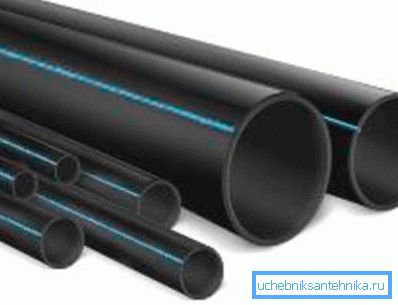
Main settings
Key dimensions
For the construction of hot and cold water supply systems today are used pipes from a variety of materials.
If you are planning to do the installation yourself, then most likely you will use these types:
- Steel.
- Copper.
- Polyethylene.
- Polypropylene.
- Metal-plastic.
Despite the fact that the range of products from each category is quite wide, and the sections are basically standardized, certain differences are still present. That is why when buying materials for laying plumbing in a private house you need to pay attention to the functional parameters of the products.
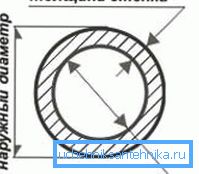
Dimensions of water pipes are determined by such values:
- Dn is the nominal diameter.
- Dу - conditional passage (internal section, expressed in millimeters).
- Wall thickness (the more - the stronger the structure, and the higher the pressure it will withstand).
- Outside diameter.
Note! The size of the outer diameter is very important when we are planning a hidden installation of water supply and preparing the grooves for laying out the contours. In other cases, it is better to operate with the concept of “conditional passage”.
Inches and millimeters
Very often, manufacturers indicate the size of water pipes in inches - and a millimeter up or down can cause an insufficiently tight connection:
- When joining products from the same material, such situations rarely occur, but when replacing, for example, steel structures with plastic or copper, you can get into an unpleasant situation.
- The thing is that inches are used to mark the thread that is cut on the outer surface. And since the wall thickness of different models may vary, there is a risk of error.
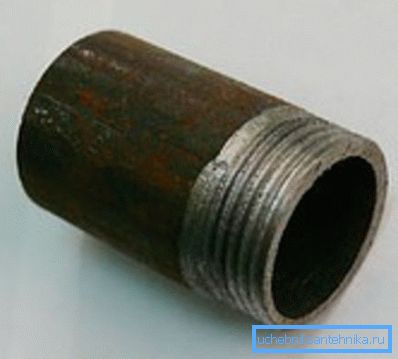
Tip! In order not to be confused, it is better to focus not on the outer diameter of the product, but on the value of Dу - it is precisely this that corresponds with the inch marking.
The most common dimensions of water pipes in mm and inches are given in the table below:
| Thread, in inches | Conditional pass, in millimeters |
| 3/8 | ten |
| 1/2 | 15 |
| 3/4 | 20 |
| one | 25 |
| 1 1/4 | 32 |
| 1 1/2 | 40 |
| 2 | 50 |
| 2 1/2 | 65 |
| 3 | 88.5 |
| four | 114 |
As for the practical use, they usually focus on the following data:
- The instruction recommends the use of pipes with a cross-section from 3/4 inch to 1 1/2 inches, depending on the required capacity.
- Thicker products are usually used for laying of risers and arrangement of water-bearing highways.
dimensions
Metal
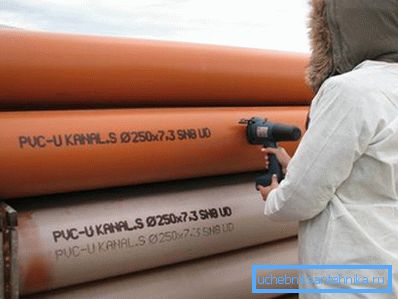
Until recently, the most common type of parts for laying water pipes were steel products.
The labeling of such elements usually indicates two parameters:
- Outside diameter.
- Wall thickness
To find out the internal cross-section, it suffices to subtract two wall thicknesses (in millimeters) from the size of the diameter.
The most popular steel construction mix is listed below:
| Outside diameter | Conditional pass | Wall thickness | ||
| Lungs | Standard | Reinforced | ||
| ten | 17 | 2.0 | 2.2 | 2.8 |
| 15 | 21.3 | 2.5 | 2.8 | 3.2 |
| 20 | 26,8 | 2.5 | 2.8 | 3.2 |
| 25 | 33.5 | 2.8 | 3.2 | 4.0 |
| 32 | 42.3 | 2.8 | 3.2 | 4.0 |
| 40 | 48 | 3.0 | 3.5 | 4.0 |
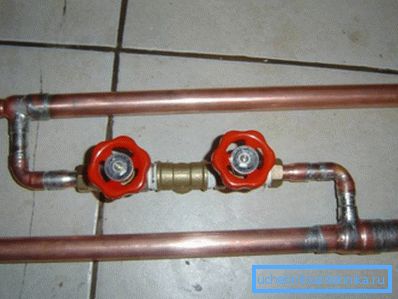
Despite the fact that the price of the material is not democratic, in some cases copper circuits are used for water supply. Their dimensions are somewhat different from steel products:
| Marking in inches | Conditional pass | Outside diameter |
| 5/8 | ten | 14 - 15 |
| 3/4 | 15 | 18 |
| 7/8 | 20 | 22 |
| 1 3/8 | 32 | 35 |
| 1 5/8 | 40 | 44-45 |
Tip! Choosing metal elements for the installation of water supply, it is worth measuring the dimensions of several products from the purchased batch using calipers. So the definition accuracy will be much higher!
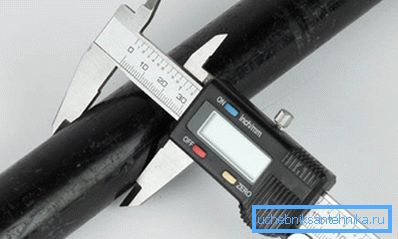
Plastic
The dimensions of plastic pipes for water supply, which are widely used today as an alternative to metal contours, are also very diverse. At the same time, many manufacturers of polypropylene, polyethylene and metal-plastic parts use their own dimensional grids, therefore it is desirable to use designs of the same brand within the same system.
Of course, the discrepancies, if they arise, will be insignificant, but for an inexperienced master they may be difficult.
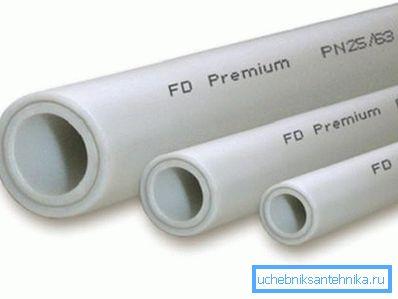
Size table of plastic pipes for water supply (polypropylene of different density) contains information on the most popular models. All dimensions are in millimeters:
| Outside diameter | PN30 | PN20 | PN10 | |||
| Wall thickness | Internal section | Wall thickness | Internal section | Wall thickness | Internal section | |
| sixteen | - | - | 2.7 | 10.6 | - | - |
| 20 | 3.4 | 13.2 | 3.4 | 13.2 | 1.9 | 16.2 |
| 25 | 4.2 | 16.6 | 4.2 | 16.6 | 2.3 | 20.4 |
| 32 | 3.0 | 21.2 | 5.4 | 21.2 | 3.0 | 26.0 |
| 40 | 3.7 | 26,6 | 6.7 | 26,6 | 3.7 | 32.6 |
| 50 | 4.6 | 33.2 | 8.4 | 33.2 | 4.6 | 40,8 |
| 63 | 5.8 | 42.0 | 10.5 | 42.0 | 5.8 | 51.5 |
| 75 | 6.9 | 50.0 | 12.5 | 50.0 | 6.9 | 61.2 |
Of course, when laying communications, other sizes of plastic water pipes can be used. However, to solve most of the problems that arise during the performance of routine repairs, the information indicated in the table will be quite sufficient.
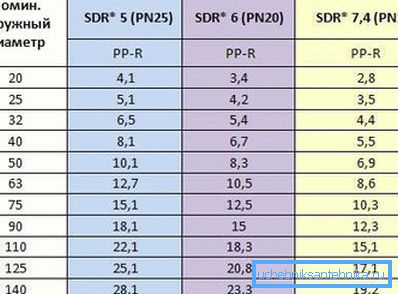
Conclusion
Pipe dimensions for plumbing should be respected as accurately as possible. Even with a deviation of a fraction of an inch, the hermetic connection of two sections of the network or the connection of the fitting will be almost impossible, which means that the reliability of the entire system will be compromised (see also the article What depth of water pipes is optimal).
You can study the dimensions and marking in more detail by reading the regulatory documents and watching the video in this article.